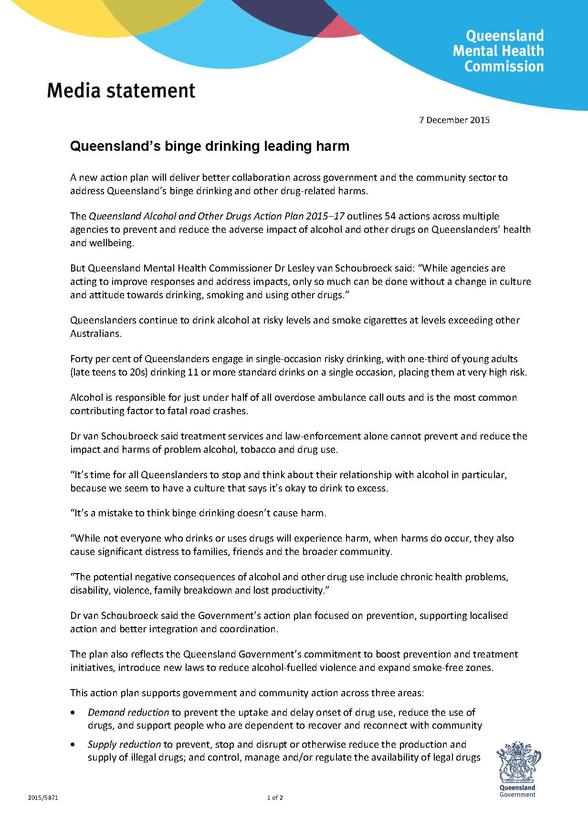A new action plan will deliver better collaboration across government and the community sector to address Queensland’s binge drinking and other drug-related harms.
The Queensland Alcohol and Other Drugs Action Plan 2015–17 outlines 54 actions across multiple agencies to prevent and reduce the adverse impact of alcohol and other drugs on Queenslanders’ health and wellbeing.
But Queensland Mental Health Commissioner Dr Lesley van Schoubroeck said: “While agencies are acting to improve responses and address impacts, only so much can be done without a change in culture and attitude towards drinking, smoking and using other drugs.”
Queenslanders continue to drink alcohol at risky levels and smoke cigarettes at levels exceeding other Australians.
Forty per cent of Queenslanders engage in single-occasion risky drinking, with one-third of young adults (late teens to 20s) drinking 11 or more standard drinks on a single occasion, placing them at very high risk.
Alcohol is responsible for just under half of all overdose ambulance call outs and is the most common contributing factor to fatal road crashes.
Dr van Schoubroeck said treatment services and law-enforcement alone cannot prevent and reduce the impact and harms of problem alcohol, tobacco and drug use.
“It’s time for all Queenslanders to stop and think about their relationship with alcohol in particular, because we seem to have a culture that says it’s okay to drink to excess.
“It’s a mistake to think binge drinking doesn’t cause harm.
“While not everyone who drinks or uses drugs will experience harm, when harms do occur, they also cause significant distress to families, friends and the broader community.
“The potential negative consequences of alcohol and other drug use include chronic health problems, disability, violence, family breakdown and lost productivity.”
Dr van Schoubroeck said the Government’s action plan focused on prevention, supporting localised action and better integration and coordination.
The plan also reflects the Queensland Government’s commitment to boost prevention and treatment initiatives, introduce new laws to reduce alcohol-fuelled violence and expand smoke-free zones.
This action plan supports government and community action across three areas:
- Demand reduction to prevent the uptake and delay onset of drug use, reduce the use of
drugs, and support people who are dependent to recover and reconnect with community - Supply reduction to prevent, stop and disrupt or otherwise reduce the production and supply of illegal drugs; and control, manage and/or regulate the availability of legal drugs
- Harm reduction to reduce the adverse health, social and economic consequences of the use of alcohol, tobacco and other drugs.
Queensland Network of Alcohol and Other Drug Agencies (QNADA) Chief Executive Officer Rebecca MacBean said the development of a new plan has strengthened the partnership between the Commission, Government and non-government agencies to minimise the harms associated with alcohol and drug use.
“As part of the process, we were able to engage with frontline workers, clients of treatment services, their families and friends, who made a significant and valuable contribution to developing this plan,” Ms MacBean said.
“I feel confident that Queenslanders who experience problems related to their substance use, or the substance use of a loved one will have access to better supports once this plan has been implemented.”
Dr van Schoubroeck said reform would be ongoing as a new National Drug Strategy, the National Ice Strategy and the Queensland Mental Health, Alcohol and other Drug Services Plan will be delivered over the next 12 months.
She said a reference group partnering government agencies, non-government organisations and professional bodies would oversee the action plan’s implementation, identify emerging issues and good practice.
Significant actions include:
- A three-year education and awareness campaign targeting young people about safe drinking and alcohol-related violence.
- An Alcohol and Other Drugs Education Program for young Queenslanders in Years 7 to 12.
- Additional specialist drug and alcohol intervention teams in Logan, Townsville and Rockhampton Hospitals’ Emergency Departments.
- Clinical state-wide training and resources for workers responding to ice and other substances.
- Additional frontline treatment responses in Cooktown, Weipa, Logan, Gold Coast and Rockhampton.
- Increased access to alcohol and other drug treatment and support services for young Aboriginal and Torres Strait Islander people.
- A two-year mental health demonstration project in Brisbane’s inner-north to test a new integrated housing, health and social welfare support model.
Key facts
- Queenslanders slightly exceed national levels of illicit drug use, mostly due to greater cannabis and meth/amphetamine use—11.1% and 2.3% of Queenslanders used cannabis and meth/amphetamines
- The proportion of Queenslanders using meth/amphetamines has remained relatively stable, but regular meth/amphetamine users have shifted to ice, increasing from 19.9% to 45.5% (2010-2013).
- Alcohol misuse was conservatively estimated to cost $14.3 billion nationally (2010) including health system, criminal justice system, lost productivity and road accident costs.
- Younger teens are smoking and drinking less than other Queenslanders, with 72% abstaining from drinking.
- Less than one per cent of Queenslanders over 14 use heroin or inhalants.
- Aboriginal and Torres Strait Islander people are more likely to abstain from alcohol (23%) than non-Indigenous people.
-
 Alcohol and Other Drugs Action Plan FINAL (PDF, 419.91 KB)
Alcohol and Other Drugs Action Plan FINAL (PDF, 419.91 KB)

